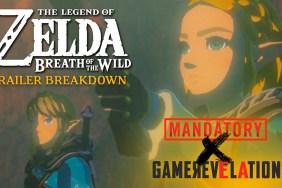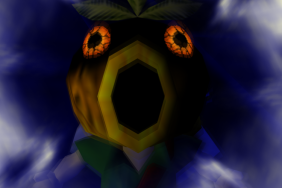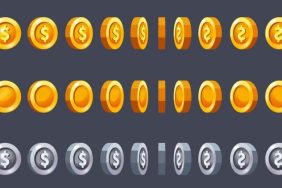The Legend of Zelda games sit atop the pantheon of video game royalty. Iconic is almost an understatement at this point. Decades of impeccably crafted titles paved the way for the newest addition to the series. That said, The Legend of Zelda: A Link Between Worlds is the first Zelda game I’ve ever completed, and for good reason.
Now that you’ve caught your breath, rest assured I don’t live under a rock. I’ve played a number of key games in the series, but growing up with parents who wouldn’t allow me to own a console clearly hindered the amount of time I could ever hope to spend with Link and company. Times have changed, but the quality of Zelda sure hasn’t.
My fondness of the little guy in green has always been that of distant admiration. I appreciate what he stands for. I mostly appreciate the experiences he’s given to the multitude of fans who adore and defend him with equal and uncompromising vigor. In short, A Link Between Worlds has some big shoes to fill.
What we’re given is a sequel to 1991’s beloved Super Nintendo title, The Legend of Zelda: A Link to the Past. It shares its inspiration, soundtrack, and zones with its predecessor, but in a way that is clearly modern without losing the feel of being instantly recognizable.
The most obvious example of this is the use of 3D effects. Not only does it bring out the detail and personality in the monsters you face off against, but plays perfectly into the bold new designs of dungeon levels and puzzles. Having the extra depth and perspective when Link jumps heroically between moving platforms that seem an impossible distance below your character is terribly satisfying. Cliff faces, bottomless pits, and dark fractures in the over world feel ominous. The world has a distinct personality despite its simple visuals that don’t push the 3DS very far.
The land of Hyrule itself is filled with familiar faces and places. As a new incarnation of Link, you’re back to being the silent hero. The story is introduced quickly and unapologetically (a theme we’ll discuss later), the formula of which hasn’t changed much. The Princess Zelda has been captured and all of Hyrule is in terrible danger unless you do something.
The new addition is the villain Yuga. He’s obsessed with transforming the descendants of powerful sages into paintings to preserve their beauty and steal their power in hopes of unleashing the evil demon Ganon. You almost become permanent brush strokes on a wall if not for a seemingly ordinary bracelet that holds a secret power. The bracelet lets you merge into walls as a 2D portrait of yourself. This becomes the key feature of the game as new puzzles and areas of the world are unlocked by your newfound power.

This brings me to my favorite aspects of A Link Between Worlds: the outside areas in Hyrule are a joy to explore. The game gives you easy and immediate access to almost all of the areas in the game. Special attention is paid to showing you small gaps, entrances, and treasure chests that are just out of reach. This always made me feel like I had to come back to the same areas once I found the right item, or gained a new ability that could help me reach those hidden goodies. I was always worried about making sure I looked at every zone from every angle. I spent extra time and care combing over the same spots again and again, convinced there was something waiting to be found. I hate the feeling that I’m missing out. This is exactly how the game sucked me in.
To make this even more effective, most of the infamous items and gadgets at Link’s disposal are also given to you very early on. This emphasis on convenience and a game world that presents missions in a way that lets you chose the order you complete them in is remarkably liberating.
The system of discovering weather vanes throughout the game world and using them as nodes for quick travel drives home this philosophy. These are also the only places you can safely save your progress.
Hyrule and its darker counterpart aren’t very large, but there’s plenty to do. The open nature of the game world, and the quickness with which the game tosses you out into your first missions let me have brief moments of feeling lost and unsure of exactly where I was going, or what I was supposed to be doing. Even without a perfect sense of direction, I was never frustrated. Most areas that were unexplored had something useful to discover, and once I really needed to get back on track, I knew there were always characters I could go back to for hints.

One of the more intriguing characters you’re introduced to is Ravio. In a story that only someone like Nintendo can brush off so easily, Ravio is a traveling merchant who finds you passed out after a battle with Yuga. He drags your unconscious body to what he assumes is an abandoned home. The real twist here is that it’s your home. He then asks if he can stay for a while, but you kind of owe him one. He then proceeds to set up shop in your house to bleed you dry of rupees. Ravio holds all the key items you’ll need to solve the incredible puzzles strewn about the world. The only caveat is you usually rent most of the items (or all at once if you’re like me) and any item you took will return to Ravio if you die.
Fans of the series will enjoy seeing standard items like the Hookshot back in action. This item is great for grappling across gaps or snatching items that are out of reach. The new Tornado Rod is perfect for snuffing out fires and lifting you up in the air to land on top of a boss or a moving platform.
Challenges often require judicious use of various items, as well as your transformative powers. The amount of times you can use each item or the duration you can remain in 2D painting mode revolves around a universal power bar that replenishes over time. This forces you to have at least some sort of strategy when tackling complex tasks.
Puzzles and level design are well thought out and enjoyable. They encourage you to look at problems from multiple angles, which can be very nice in 3D. Any time vertical space is introduced, it’s done extremely well. You’re often forced to consider every part of a room, except the ceiling when working through a dungeon.
Boss fights were less of a brain teaser than a more traditional process of memorizing patterns and acting accordingly. You’ll try a few different items before you find the tool that fits the job, but there are ways to keep yourself from dying and losing all of your progress.
As I progressed through the game, I was consistently surprised with how simply satisfying the experience was. I never felt like completing any one task was a chore, even when some dungeons sequences became repetitive. The game is well paced, rewarding, and engaging enough in short bursts of play, or longer gaming sessions.
I also wasn’t enthralled. I wasn’t on the edge of my seat waiting to unlock the next part of the story. I didn’t feel like I was working my way through treacherous zones for anyone but myself. There are very few characters that develop nicely throughout the game to create real connections. The gameplay is truly what sticks with me.
I keep thinking back on the puzzles, the combination of exploring every nook and cranny of the two opposing worlds added layers to those challenges. The Legend of Zelda: A Link Between Worlds is a well presented package that’s consistent in its delivery. Of the 16+ hours I played, I felt compelled to keep playing during every moment, and few games can say that. This game is a worthy addition to the Zelda family, and certainly worth your time and money.

Mike White is a contributor for CraveOnline and co-host of the gaming podcast Next Gen News. You can follow him on Twitter @theWhitestMike.
Copy provided by publisher. The Legend of Zelda: A Link Between Worlds is exclusive to Nintendo 3DS.








